#larsen museum
Explore tagged Tumblr posts
Text




Johannes Larsen museum, Kertemind, Denmark
I didn't have a clue what kind of a museum this one would be, but it was beautiful. It is the artist villa turned into a museum. Everything is there the way it was when he lived there together with his wife. There is a huge garden with chickens and a lovely place to drink some coffee. Larsen painted a lot of birds.
3 notes
·
View notes
Text

Knud Kyhn (March 17, 1880 - 1969) was a Danish animal and landscape painter and porcelain/ceramics sculptor, who created many animal figurines for the three major, Danish porcelain factories: Royal Copenhagen, Bing & Grøndahl, and Kähler.
He trained at the Royal Academy and Zahrtmann's school, and traveled widely to observe animals and birds, esp. in Northern Europe. His style of painting aligns with that of Fynboerne, esp. Johannes Larsen.
Above: Vandrefalken jager, 1945 - oil on canvas (SMK)
#art#danish artist#knud kyhn#1940s#oil on canvas#animal painting#bird painting#peregrine falcon#fynboerne#johannes larsen#royal copenhagen porcelain#bing & grøndahl#kähler#danish royal academy of fine arts#kunstnernes frie studieskoler#smkmuseum#smk#statens museum for kunst#otto bache
5 notes
·
View notes
Text
Scenes From New York Comic Con 2023: Day One (Part 1)
Scenes From New York Comic Con 2023: Day One (Part 1)
Oh yes my friends, its time to get excited because you have arrived at the very first official post of the photo editorial takeover and event overview that PiercingMetal is serving up from the famed New York Comic Con which began this past Thursday. As you read this I am heading there for the fourth and final day but the coverage you’ll see is starting from the very top. The 2023 convention marks…
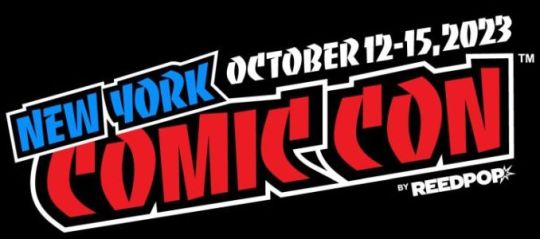
View On WordPress
#adam hughes#agnes garbowska#alex saviuk#artgerm#barbie chula#chris hamer#chris uminga#convention reviews#cosplayers#curtis clow#david mack#dean haspiel#dirk manning#erik larsen#jae lee#javits center#jim salicrup#kirby museum#louise simonson#new york comic con#new york comic con 2023#nycc 2023#peach momoko#photos from new york comic con 2023#planet atmos#pop insider#reedpop#stanley lau#steve orlando#sumerian comics
0 notes
Text
Johannes Larsen, the Danish Bird Painter
Johannes Larsen, the Danish Bird Painter
Johannes Larsen (born 1867- 1961) was a Danish painter specialising in painting birds. He was born and died in the small coastal town of Kerteminde on the island of Funen. Recently, my husband and I drove two hours to visit this lovely place with a museum and the painter’s home and garden. We have an artist friend, Simon Bang from Copenhagen, who had a massive painting at a special exhibition on…
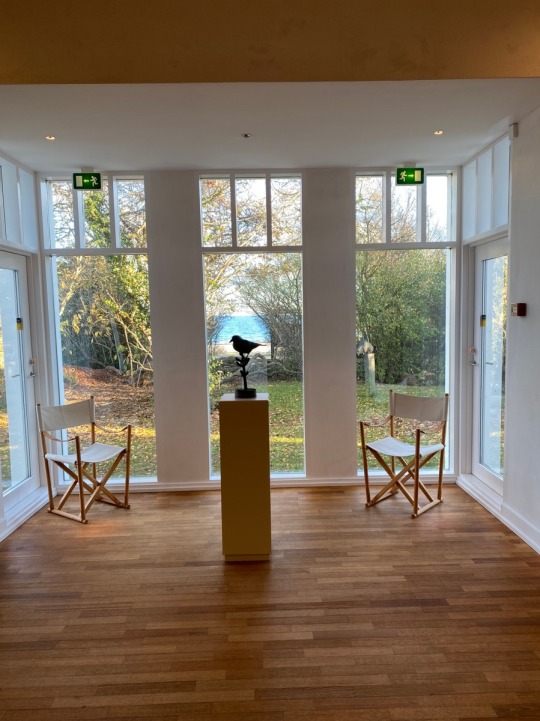
View On WordPress
0 notes
Text

Hazel Larsen Archer Ray Johnson at Black Mountain College 1948 Gelatin silver print 13 3/4 × 9 7/8 inches The Morgan Library & Museum
37 notes
·
View notes
Text


Emigrants at Larsens Square 1890 by Edvard Petersen; with detail.
(Museum: ARoS Aarhus Kunstmuseum) Credit: Courtesy of Wikimedia Commons
10 notes
·
View notes
Text
No. 55 - Finnair [+ Centenary Livery]
So I know I'm in the process of writing a bunch of longer posts and thus haven't posted in absolutely forever, but I had to let something cut the line very quickly because in this case it was somewhat time-sensitive. I've missed the actual date by two months, but if I get in a post while it's still 2023 (...in my timezone, at least, so sorry to actual Finns busy enjoying 2024) I think that counts, and this entire blog is about what I think, so that means it counts.

On 1 November 2023 Finnair became the sixth airline to turn 100 years old, consistent with its status as the sixth oldest airline in continuous operation. I wish I'd started this blog earlier in the year, or prioritized differently, because Aeroflot and Czech Airlines also turned 100 in 2023, but...well, I didn't. You'll probably see them both in 2024 instead. Finnair, however, was requested by @kuivamustekala - particularly their centenary liveries. Requested a long time ago, even. So I'm going to hope that late is better than never and throw Finnair one last birthday party to wrap up 2023 by looking at where they started, where they are now, and what they've been doing to celebrate.
1923: PROTO-FINNAIR
Finnair, obviously the flag carrier of Finland, was founded in 1923, but its first service was in early 2024, using a Junkers J.13 (fitted with obligatory floats, as there were no suitable airstrips in Finland at the time).
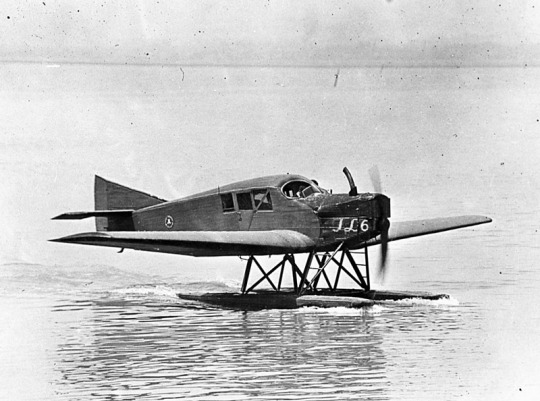
image: Joseph Eaton via US Navy National Museum of Naval Aviation This is actually the US license-built version, the Junkers-Larsen JL-6, but I couldn't find any pictures of actual J.13s on floats.
Unfortunately, Finnair was founded under the name 'Aero', which is probably the actual single worst name for an airline I have ever heard. We can jest and joke about things like Jet2 and Fly Air, but I sincerely do not think I have ever seen anything with worse SEO than an airline named 'Aero'. Even for 1923 this was fairly dire - back then, as for much of history, airlines were generally named for the area they served. Aero may have been a private company, rather than state-owned, but that didn't mean they couldn't name themselves for the area they served - private airlines have always done this and still do. Incredibly enough, there was a second 'Aero' founded in Poland in 1925, but that was quickly merged into what would become LOT Polish Airlines, shedding the name like a chrysalis.
Bafflingly, even when the Finnish government bought the airline in 1946 (they still own a majority share of it today) they didn't bother to change the name. They did begin writing 'Finnish Airlines[1]' on the fuselages, but as far as I can tell this appears to have been more of a stylistic flourish of sorts than an actual rebrand, or maybe even a clarifying subtitle on the very nonspecific name. In 1953 they began marketing under the much catchier 'Finnair', but the company remained legally named 'Aero' until literally 1968 and the fuselages still read 'Finnish Airlines'.

image: Finnair An Aero/Finnish Airlines Convair 340, photographed in 1953 in a livery which included both the large 'Finnish Airlines' wordmark and 'Aero' on the tail.
Early Finnair, like most early airlines, didn't have a particularly standardized livery for its fleet, and even where it did it's not very well documented. Finnair unfortunately has some of the poorest documentation for livery evolution of any large airline I've discussed so far, which really surprised me. That said, it's when the name became Finnair that things begin to be easier to find, and so that's where I'll begin.
1968: CLASSIC FINNAIR

This original logo[2], introduced in 1968, was designed by Kyösti Varis - at least, that's what every logo database I looked in said. I actually couldn't find either Finnair or Varis confirming this[3], but I still think it's probably true. Unlike designers like Vic Warren and Lindon Leader, who wrote and gave interviews about their designs for major airlines, Varis appears to have other preoccupations. He is enormously successful and prolific, to the point where his website doesn't even mention Finnair. According to the timeline he provides he would have either been creating this logo freelance or in his very last days at Advertising Agency SEK (probably the latter, since they did the two subsequent iterations), and based on his history as a typographer I think it's safe to say the letterforms are his creation as well. Also according to his timeline, he is younger than Finnair! And we almost have the same birthday.
I like the original Finnair branding. It's not ostentatious, but it's nice and sleek, with that forward slant I love in airline branding and a long unbroken line (both in the 'F' logo and in the even heights of the letters in the wordmark). It looks aerodynamic and the rounded, blocky letters have a hint of that 60s futurism while not being gimmicky. It's kind of incredible looking at it next to the '91-'94 FedEx wordmark, which occupies the opposite end of the sliding quality scale of TRON-looking text. The design as a whole is simple enough to easily reproduce but distinct enough to easily recognize. The shade of blue chosen is a fair bit lighter than the blue of the Finnish flag, but visually pleasing enough. They basically keep iterating on this general concept for the rest of their history, which I think is fantastic - no need to get rid of something that's working for you. It's nice to see an airline not feel pressured to reinvent its logo and livery every 20 years. That's about it for the logo[4] - what about the livery?
As mentioned prior, Finnair's liveries, before quite recently, were very poorly documented. Variants definitely existed between different types and different periods in the company's history, but the broad strokes of the branding seem to have remained almost startlingly intact for around thirty years.
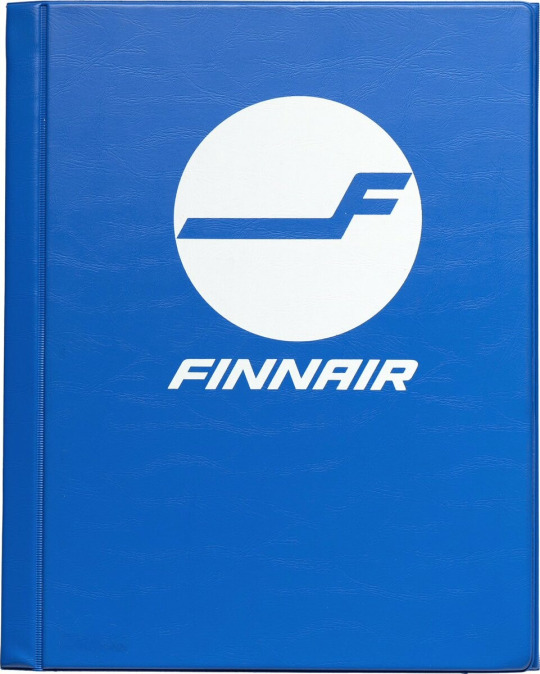
image: Letterform Archive The cover of a style guide from 1985. If it's changed from the 1968 original, I can't tell how.
But I'm really here to talk about one thing: the liveries.
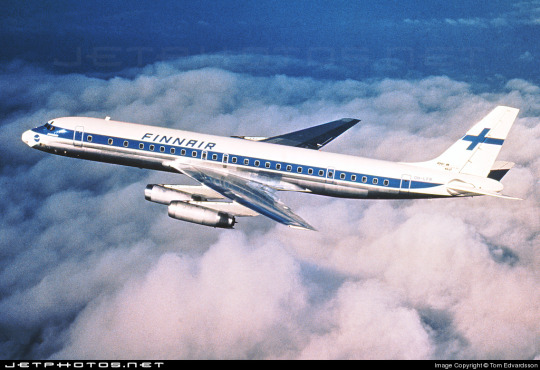
The above image was from Finnair's own archive and was taken in 1968[5], making it contemporary with the introduction of the Kyösti Varis branding, as well as lining it up with the 1969 addition of DC-8s, like the pictured airframe.
For the majority of Finnair's history, their livery is always going to look something a little bit like this. Primarily white, with a thick blue cheatline (in what I call the domino-mask style, where it's vertically centered around the cockpit windows) that lightly flips up at the very end and a blue cross on the tail to represent the Finnish flag.
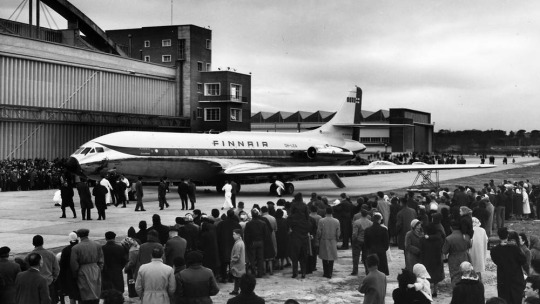
Finnair says this image is from 1960. If so, the livery was already well on its way to existing prior to 1968, with my guess being that it was introduced in 1960, along with the first jets in Finnair's fleet - the pictured Sud Aviation Caravelle, which pioneered the swept-wing, aft-engine format later seen on immensely popular jets like the DC-9 and Tu-134 - the latter of which was commissioned specifically because Nikita Khrushchev was so impressed with the Caravelle's aft engines and the quiet cabin experience they provided. It's a plane with a lot of unique visual features, featuring a nose that looks almost slanted downwards (a copy of the de Havilland Comet nose), a cruciform tail (instead of the more efficient T-tail used for future rear-engined designs), and triangular passenger windows. Most crucially, though, it was more or less the first short-range jet on the market. This made it perfect for an airline like Finnair, which at this point didn't really go that far from actual Finland.
This 1960 photograph provides a very strong blueprint for what was to come. It's the first iteration of the livery to say 'Finnair' instead of 'Finnish Airlines', and it's introduced a modern-for-1960 single-rule cheatline, although this early version was flipped horizontally, curling up at the front to frame the cockpit windows instead. (I think the white paint also cuts off behind it, leaving the space in-between the cheatline and painted nose blank metal, but in black-and-white it's somewhat hard to tell.) I do think I prefer the modern version. The use of the white downward curve with no blue hemming it in creates a really nice effect where it blends with the unpainted metal underside, due to the metal being right where you would expect to see a shadow anyway. (This effect is why I'm not quite sure where the paint ends on the Caravelle, and am just guessing based on which parts are noticeably reflective.) I definitely prefer the change made to the tail, where the single line of trim at the end of the rudder was replaced with a white canvas for the Finnish flag.

While I do tend to have a slightly pessimistic outlook on primarily-white liveries, I will say that if you're going to have a primarily white plane, and you are the flag carrier of Finland, this is a fairly understated and stylish way of incorporating it. While I probably would have done it on the main body, over where the first set of doors is, instead of on the tail, I think this is far from the end of the world. What they have is a nice, elegant taper where the tip seems to point directly at the tailplane, and it looks neat and intentional. A lot of airlines tend to just awkwardly slap a logo on their tail, which often looks really sloppy due to poor alignment or even just out-of-place entirely, and Finnair avoids that while keeping the tail from being completely blank. Having an element on the tail that's more horizontal than vertical, like the old 'AERO' rectangle or the tail rectangle on the one decent livery Lufthansa ever had.
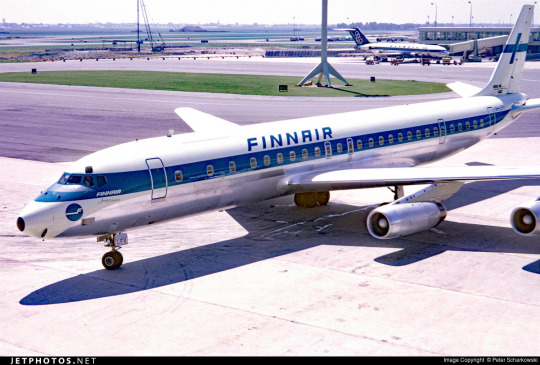
If you look in the background, you can see that wow has the Olympic Air livery looked like that for a long time! But that's a story for soon.
Additionally, some details were added on the nose. You can see on this DC-8, photographed in 1969, that the nose features an e-girl cheek stamp of the Kyösti Varis logo. Next to it is the name of the aircraft - in this case, Jean Sibelius - in really difficult-to-read thin text. (Finnair unfortunately appears to have stopped naming their planes by the late 1970s, but at one point they would frequently be named for Finnish people and places.) The 'domino mask' goes quite a bit beyond the cockpit windows to create a wider line from the side. I wish that the logo could have been integrated some other way, because the extra little blue thing just looks cluttered, but I can't imagine how they would do it without just replacing the cheatline. I mean, that would have been an option - indeed, it's what I would have done[6] - but assuming that they keep this general look I think the logo just can't fit in on the livery. The engine nacelles, maybe? Though that would still present issues on the Caravelle, where the engines are directly over the cheatlines. I also wish they would have made it a bit easier read the name, because I like to know what the plane's name is - thankfully, some later paint jobs actually do this before, tragically, Finnair stops writing names on their planes at all.
I believe this to be the strongest iteration of the classic Finnair livery, and it was pretty obviously optimized for the DC-8. Modern airlines tend to not bother adjusting their liveries between types, creating some absolute travesties of proportion, but Finnair boldly went in the opposite direction by modifying it for each airframe and yet still having it look worse.
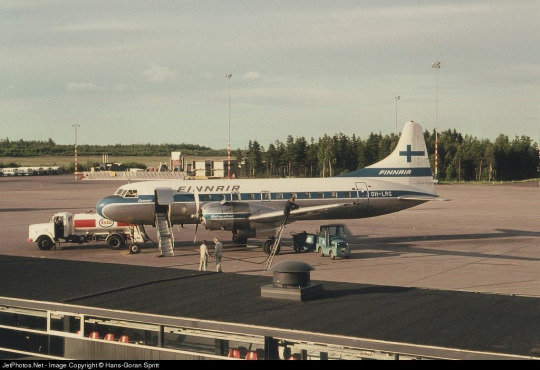
The sharpest deviation arises in the CV-440 version of the livery. This image is from 1971, just two years after the DC-8 liveries would have carried their first passengers, and it's wildly different. The cheatline is lowered sharply, sitting below the cockpit windows and wrapping around to contour the body of the airplane. There's a certain je ne sais quois to the domino mask that I find myself missing here. This design also has an unnecessary second 'Finnair' added to the tail, which kind of looks awkward stacked on top of the existing cheatline besides being redundant, and the Finnish flag on the tail is somewhat awkwardly made free-floating. It feels a lot less sleek and a lot more arbitrary.
On the other side of the plane the cheatline goes down quite a bit farther than on the jet models, probably because they thought it would be a better way of negotiating the Convair's rather bulbous nose, and I actually think I prefer the wide, upturned variant. This version, if anything, is too close for my taste to the livery VARIG operated in a similar timeframe. There are a lot of differences, yes, but in the 70s having one big solid cheatline on a white body and metal underbelly was the equivalent of the Lufthansa Line, so if you toed said line, be it cheat or Lufthansa, you risked becoming easily mistakeable for any airline with too similar of a color scheme. And blue-on-white was maybe the most common color-scheme at the time.
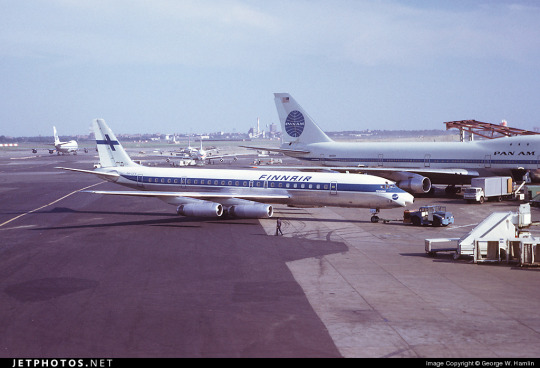
I doubt Finnair shared many tarmacs with VARIG, but here they are with Pan Am, and they could also expect to run into airlines like Sabena, Icelandair, and probably a half-dozen I've never heard of, all competing to be the one the others get mistaken for. It's a tricky position to be in.
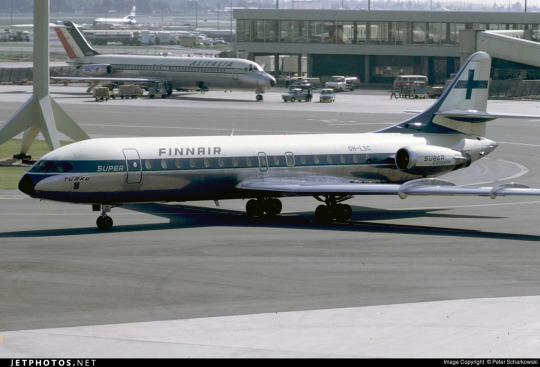
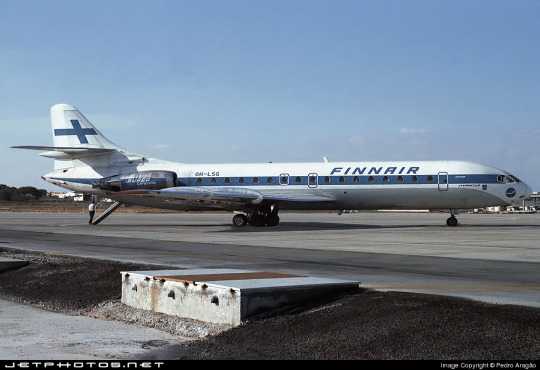
I do quite like the livery on the left, maybe even more than the DC-8 one, but I can't seem to find any other airframes painted like this. I'm not sure why this one is.
These images are from 1971 and 1969. They are both the same model of airplane - the Super Caravelle or Caravelle 10B. Their liveries are completely different. And that's just how it was back then - not even standard within the same airline, somehow still trying to stay distinct from dozens of other non-standardized blue-on-white cheatlines.
When evaluating classic Finnair, I have to keep myself tempered in both directions. When I think it's clean and well-proportioned I have to remind myself that it's just a complete nothingburger. When I think it's a lazy and cowardly non-design I have to remind myself that, no, at its best classic Finnair does look like it was designed with some thought, and it does have some traits that feel at the very least interesting enough to merit not being totally dismissed.
But...look, I have to give classic Finnair a D+. Because they tried, and they did something, sure, but it's ultimately not something especially memorable and the implementation is just spotty.

Even given a canvas like the DC-10, they fumbled. The DC-10, in my opinion, was a big test for them. And I do mean big. In the DC-10 is a plane with all the space in the world to add visual elements, and a space where just a couple lines can go from a detail to a fin that towers over anything that isn't a 747, showing off the Finnish flag as if someone had flown it from a building mast. The third engine, which I feel like a lot of airlines really struggle with on the DC-10, gets a nice horizontal line of writing that's not intrusive but helps prevent it from feeling like a giant gap. The wordmark gets larger, is moved forward, gets to really own the space it takes up instead of being squeezed in. And...they made the cheatline just....a really thin flat line that looks bad and stiff and boring. There's nothing setting them apart from Icelandair, and Icelandair's livery from this point in time was so boring that my only comment on it was that it looked like they forgot to paint the rest of the plane. You can do white planes well, but Finnair just really doesn't get there.
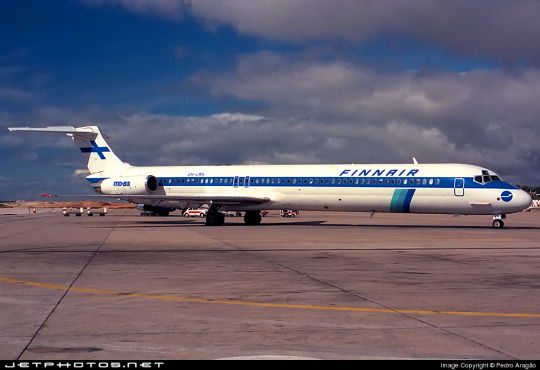
...hey, Finnair? You can't just decide to do belly stripes but worse, Finnair, you're literally next door to like two thirds of SAS and that livery was designed from the ground up. They have a couple of near-misses with SAS's toes but this is the one that makes me actually go 'is this allowed?'. It seems to have been exclusive to their late-80s MD-80 fleet, but it's just incredible to me that it ever happened. (That said, those three shades of blue are so nice together and I wish they had ever brought them back. I understand the appeal of sticking to the stark contrasted blue-on-white of the flag, but there's so much potential out there!)
1997: NEW TYPE, NEW LIVERY
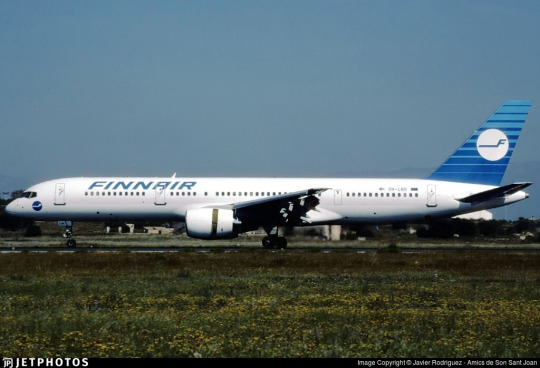
I really like the 757. It deserves a better livery than this.
Removing the cheatlines was a very trendy choice to make. This is the sad beast I call the Deltalite - a Deltalike but without the painted nacelles and belly that are usually slight redeeming factors. There's such a beautiful design on the tail that could have been put on the whole fuselage, honestly, and that's sad, but even on the most granular of levels...why keep the little cheek stamp if you have the logo visible on the tail now? Weird choice. Being so desperate to do the Deltalite thing everyone else is doing that you get rid of your country's flag on the tail is just a bad choice of priority, I think. There's not much to say about this. Honestly, I'd drop it to a D-. There's enough happening that it would lose something by being painted into Star Alliance colors, but it wouldn't lose terribly much.
2000: NEW FINNAIR

Oh, Finnair. Why? Did no airline resist the siren song of getting way too into airbrushing in the early 2000s?
Maybe I just have whatever the opposite of nostalgia is for the early 2000s, but this just makes me sad. They've made the wordmark look worse, overcomplicated the simplicity of the logo, and gone ham with the gaussian blur.

Look, it's not all that bad. The shades used on the actual plane are noticeably darker, and the colors at least don't look half bad now. And they've even bothered to paint the engines this time around! But...come on. You've changed 30 years of something that was working just fine for...this? Something which maybe climbs up to a flat D?
The 2000 brand overhaul, including the logo, was done by Finnish agency SEK & Grey. They're nearly as old as Finnair and have worked for brands as prominent as Coca-Cola and Kellogg's, but their about page puts Finnair front and center. They have an entire page describing their Finnair work.
Despite claiming to have included humanity and warmth and movement, I see none of this. I'll admit upfront I generally dislike what's dubbed 'Nordic' design. It's not the minimalism which I dislike but the banality.
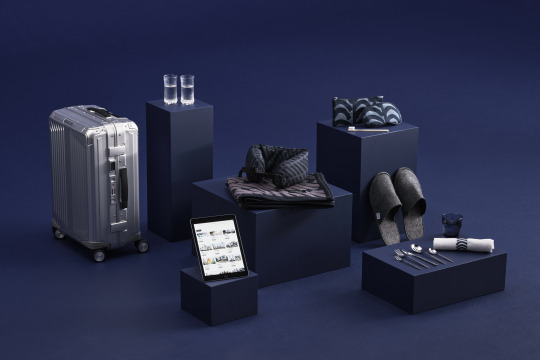
What does any of this have to do with Finnair? What here represents the history of one of the world's oldest airlines? What here really speaks to the Finnish people? Why is just designing something generic and making sure it's all crisp (when you're photographing it fresh out of the plastic, before it's been tripped over and stepped on and yanked down staircases and accidentally sat on and stained with tea) considered a substitute for designing something that people will see years down the line and get nostalgic for? I'm nostalgic as hell for Alitalia, an airline that doesn't exist anymore. I still use the bag from an amenity kit I got on Alitalia nearly ten years ago to store small essential things like toothbrushes and medication while traveling, but I wouldn't know it was Alitalia by looking at it, because it's lovely and convenient and ergonomic but it's literally just grey. It evokes nothing, and it doesn't even say 'Alitalia' on it anywhere. Nothing here could ever be considered ephemera or memorabilia. I could steal Finnair's look at the Gap.
2010: SORRY, HERE'S NEW FINNAIR FOR REAL THIS TIME

SEK & Grey gave it another shot. This one's a lot better.
I like the change in the logo, first off. And this, the word 'Finnair', is the logo, but I'm comparing it to the earlier wordmark. 2000's attempt felt like it was taking the original and just trying to sand off the corners to make it more modern, but the 2010 take on it actually shapes each glyph into a neat little space-age thing that creates this curved shape by way of a lot of straight lines, in a way that feels visually pleasing and interesting. I enjoy the square holes in the A and R, the return of the crossbar on the N, and the extreme range of widths which gives the letters a real weight to them. This isn't a typeface - these glyphs exist in the context of the word FINNAIR in this exact configuration and one of four colorways. Finnair does have a proprietary typeface, Finnair Sans, and it looks nothing like this because this is not a font, it's a logo.
I think it is a shame that this is the logo now. I really liked the F. And they haven't gotten rid of it, but it's now been relegated to an official subordinate position, according to their branding guide:
The official Finnair logo is the text version of the logo, and it is primarily used. The F emblem is used as an additional symbol.
Look, I'll always think it's a shame when your main logo is just the name of your company. Some airlines do it, and it feels like an empty space to me. It can be satisfactory but not outstanding. When you start out with a nice little symbol and then take it away, though, I do feel somewhat robbed.

It stings extra because I really like the way the new F looks. It has that long brushstrokey look and it almost makes me think of Hebrew characters. The way it tapers now really adds to the feeling of movement I get from it, and it's a great base for a livery. Now that it's darker, even though this does bring Finnair into competition with airlines like SAS, LOT, TAROM, Lufthansa, and even Ryanair when it comes to dark-blue-on-white, it also contrasts better with the main body, and it's still light enough that you can recognize it as blue. Anyway, it doesn't take a genius to know how to integrate this into a livery. Long line for the fuselage, go up to match the tail...
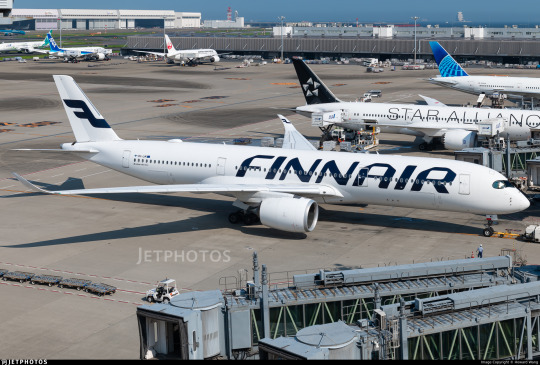
Finnair. Are you serious, Finnair?
Look! I get it! Billboards are in now, it's fine, I get it. it's probably the nicest billboard I've seen in a while, font-wise. It feels comfortable on the fuselage and it feels like it earns the space it occupies. The F is nicely centered on the tail, cuts off at a pleasant point. But...why?
I really can't be too mean about this. I want to be meaner than I actually can justify, because I think if any other airline made their plane this featureless I would hate it but Finnair's billboard livery is actually nice enough and everything is placed well enough that it's not at all unpleasant to look at. It's an acceptable livery. If maybe 25% less planes were basically all white it would shoot up in my esteem. I don't really like the fact that they put the little Fs on the inside of the wingtips of their A350s, but that's really my only nitpick. It's just sort of...bringing a really fantastic loaf of bread to a potluck when you were asked to bring baked desserts. You've done a very good job, but you didn't quite get the assignment.
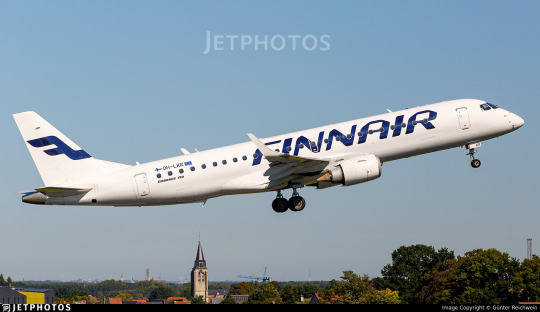
It's a bit hard to critique the modern Finnair livery in detail because I think it's executed fine. There's nothing really wrong with it except that it has a logo that could lend itself to all sorts of interesting shapes, it has 30 years of variants of a very specific design to draw on, and it's chosen to go tabula rasa just to be all clean and minimal instead of doing any of the interesting things it could have with this new start.
I want to dislike this take on the Finnair livery, but at the end of the day I just don't. I think it's completely satisfactory. A lot of airlines try to get this look and somehow end up seeming cluttered for it. Finnair is one of the only instances I can think of where a white fuselage with just a wordmark has looked okay. It isn't ugly. It hasn't failed at the thing it's trying to do, but I think that it should have tried to do something else.
At the same time, though, this is the most Finnair that Finnair has ever been. The blue cheatline and the Deltalites were stumbling over well-trod ground. The modern livery, at least, isn't sloppily tail-heavy and seemingly thoughtless.
I give modern Finnair a C. This took an excessive amount of deliberation, but it really is...good enough. It's satisfactory. It's fine! I would have taken a completely different direction, but they have done a good job with their sort of lackluster idea. It's alright. We'll check on them again in another hundred years and see where they're at.
2023: CENTENAIRY
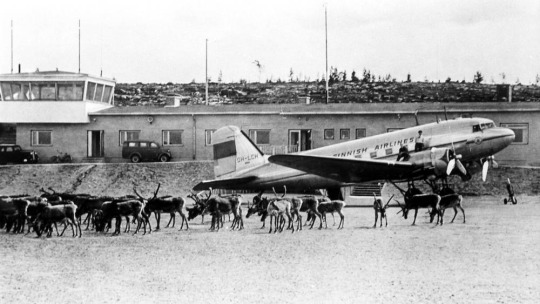
A century is a very long time. Finnair is older than my oldest grandparent. Finnair is older than over a dozen sovereign countries. Finnair is older than aerodromes in Finland. It's older than every currently operating airline except KLM, Avianca, Qantas, Aeroflot, and Czech Airlines. As of the first of November, Finnair is in triple digits.
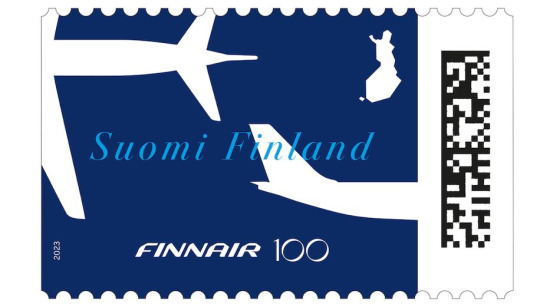
I adore this centenary stamp Finnair has put out, celebrating the long relationship between aviation and the mail. It's not complex, but it's not barren, either. It combines the dark blue of the modern livery with the light blue of the classic one, all with the white silhouettes of airplanes elegantly soaring over an outline of Finland. The outstretched white wings on the deep blue have the grace of a giant fish swimming beneath a glass-bottomed boat.
But of course it isn't just stamps. Finnair is an airline. Airlines do special liveries. Qantas and KLM both slapped a big 100 sticker on an airplane for their big anniversaries. Finnair has of course done something similar.

Three airframes - the pictured A350-900, OH-LWR, and two A320s - OH-LXK and OH-LXM - have had a 'bringing us together since 1923' sticker applied. Matching the rest of Finnair's branding, it's certainly quite minimal, but it's a nice gesture. It's not what people have been talking about. That's OH-LWO and OH-LWP, both A350-900s, who have been given something more substantial to wear.
youtube
I'm going to assume that after its renaissance on tumblr a few years back most people reading this are familiar with the Moomin franchise. I definitely am, because when I was in my larval stage my mother first taught me to read Russian using an omnibus book of Moomin stories. Creator Tove Jansson apparently designed both the shape of the eponymous white critters and the sound of the name Mumintrollen itself are designed to evoke a feeling of softness, and it's clear why these characters are so beloved.
It isn't the first time Finnair, which frequently collaborates with Finnish brands and highlights its Finnish roots, has featured Moomins.
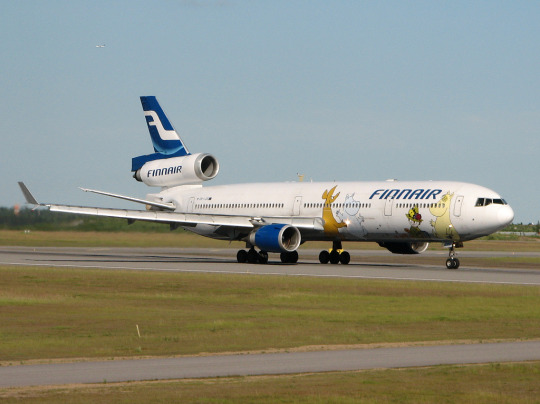
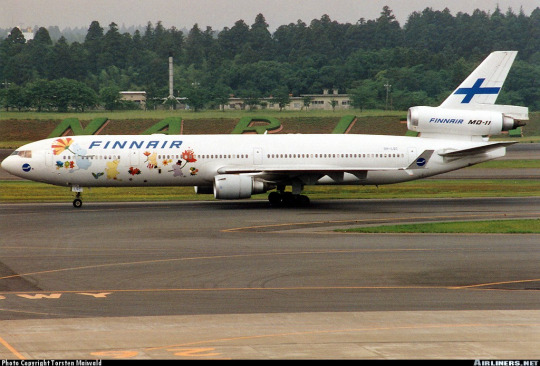
image on left: Antti Havukainen
In the 1990s, the airline first flew a Moomin jet. They had another in the 2000s. Both were withdrawn from service before 2010. It's been a while now since Finnair flew their last MD-11, but when celebrating their 100th birthday, a milestone that the vast majority of airlines will never see, they chose to do it by way of a soft Moomin embrace.
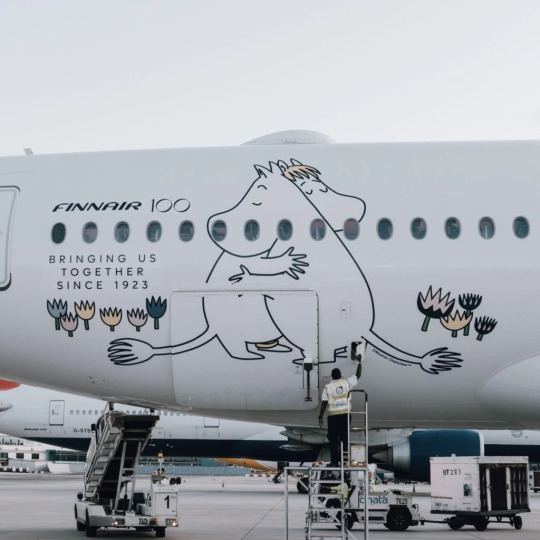
image: Changi Airport
And, I'll be honest, I think it's very sweet. It got an actual, sincere little smile out of me.
100 years is a really long time. In 1923 aviation was unrecognizable. What we would now consider an airliner didn't really exist yet - space for ten passengers, closed cockpits, and metal fuselages were the exceptions rather than the rule, and the Ford Trimotor was two years from its first flight. Cabin crew were barely even a concept. Airplanes, for all intents and purposes, were considered a type of boat. A nonstop flight across the Atlantic was a ridiculous concept. In a report published by the US National Bureau of Standards, it was said: 'there does not appear to be, at present, any prospect whatever that jet propulsion of the sort here considered will ever be of practical value, even for military purposes'. There were no aerodromes in Finland, so a small company called Aero attached floats to a plane just large enough for four passengers and took them from Helsinki to Tallinn.
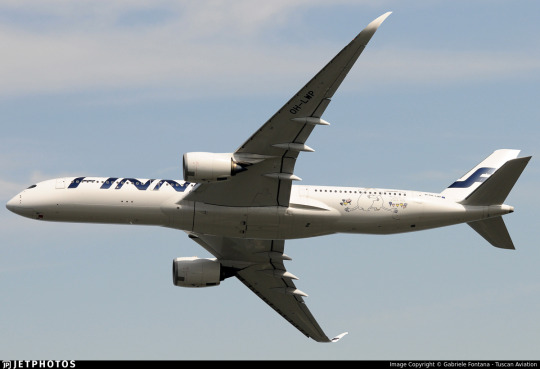
Look how far we've come.
Footnotes:
[1]: The Finnair website's history page, which I used as a source for much of the background and several images in this post, renders it as 'Finnish Air Lines', but on the airplanes themselves it clearly has no space, so I've corrected that seeming error for them. I don't know why this discrepancy exists, because as far as I know during this period they were marketing themselves as Aero so this text would only have existed on the livery itself. [2]: Actually, I very occasionally see this version where the F logo isn't fully surrounded by the circle and the F in the wordmark doesn't have the rounded top, and I don't know which came first or if the less round version is just somehow...not real? I did try to figure this out, I swear, but at some point I realized I am literally not a professional logo historian, and nobody is going to be let down if I don't brute-force an answer despite not even speaking Finnish, and I should finish writing the post before it's 2024. [3] The closest thing to an official source I can find is the descriptions of two listings for the centenary stamp including a quote from designer Ilkka Kärkkäinen attributing it to him. I don't at all doubt that he did design it, but I always like to find concrete attribution for things if I can and would hate to spread misinformation and the sparseness of confirmation here is something I find very strange. My best guess is that there's plenty of good sources on it in Finnish but nobody has bothered to make it as clear in English. [4] Admittedly this is a stretch, and I certainly don't think it was intentional, but it does remind me of the longship prow used in early SAS liveries. This motif was introduced in 1946 and continued to see use after the Finnair logo was introduced. The overlap is fairly limited in that SAS never used the longship in their logo (...I kind of want to talk about their logos one of these days) and the Finnair livery you'll see shortly doesn't look like SAS's at all, plus SAS has the extra pink on their liveries, but I couldn't get it out of my head that they do look sort of alike. [5] The absolute hero who uploaded it to jetphotos mentioned that Finnair had given him the photograph while planning to dispose of it, and this makes me wonder if the lack of documentation is just because Finnair doesn't hold onto their old materials, which makes me very sad. A lot of companies, more broadly, didn't bother to keep records until somewhat recently, but in Finnair's case it seems to be particularly egregious. As someone literally studying to be an archivist it makes me exceptionally sad to see history lost just because nobody cared enough to preserve it. [6] Maybe they didn't want to look like backwards SAS. Who can say?
#tarmac fashion week#finnair#grade: c#grade: d+#region: finland#grade: d#grade: d-#region: northern europe#era: 1960s#era: 1970s#era: 1980s#era: 1990s#era: 2000s#era: 2010s#era: 2020s#special liveries#commemorative liveries#requests
50 notes
·
View notes
Text
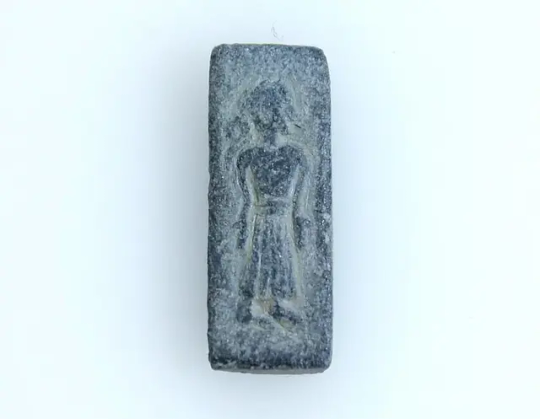
Rare Ancient Stamps Found in Denmark
In the center of Falster, southeast of Denmark, a man with a metal detector has made an important discovery. The discovery is so important that it could help write a few chapters for Danish history or at least the local history of Falster.
While Lennart Larsen was out on a rainy day and searching for anything of historical value, he suddenly heard a faint beep in his equipment, and when he checked the ground, he discovered small, interesting objects, unlike anything he had seen before.
A faint beep has indeed revealed a special stamp in the ground – a so-called Patrice – that was used to make gold images, which are believed to be gifted to the gods.
The Museum Lolland-Falster has been informed. The only two-centimeter-long object in Falster’s soil may be a trace of a former royal power on Falster, the museum said.
“This indicates that we are standing in a place that has meant some trade and probably also had some form of cultic activity. And although it’s a bit wild to say, it could also indicate that it was once a center of power on Falster,” museum inspector and archaeologist Marie Brinch from the Lolland-Falster Museum said.
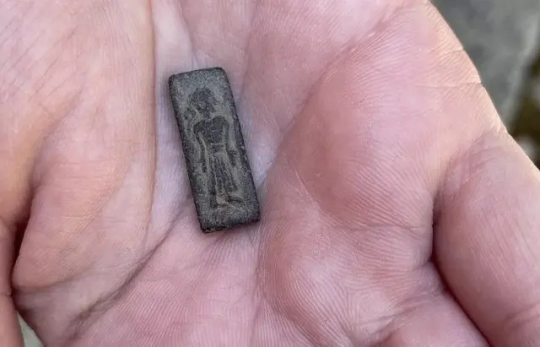
She emphasizes that the discovery was made in an area with names dating back to the Viking Age or even earlier and that the marshland was discovered in an area that had been sacrificed to the gods in the century preceding the stamp’s creation.
Archaeologists have before come across several signs of activity from the Iron Age and the Viking Age have been found, including an enormous shipyard and a large castle from the Viking Age at Falster. However, only a small number of discoveries have been made that can demonstrate where the island’s wealthy elite resided in the years prior to the beginning of the Viking Age. The new find may help to shed light on that.
Researchers have determined the tiny objects are stamps from the era just before the Viking Age. They were created between the years 500 and 700.
According to Margrethe Watt of the National Museum, who collects and researches ancient gold coins and stamps, these are extremely rare. There have only been 28 stamps discovered in the entire Nordic region, including the one from Falster, and it is a very unique stamp. South of the Baltic Sea, no stamps or gold coins have been discovered.
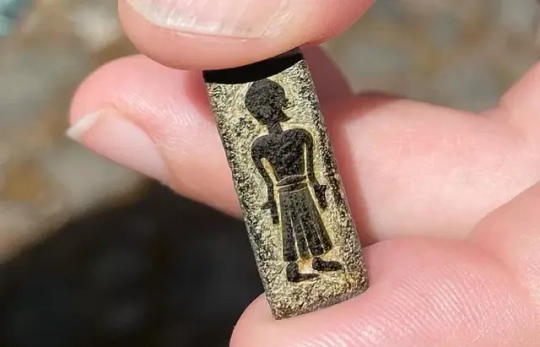
“The stamps are all very special. We only find them in the most important places of residence – those that we call the central places in the technical language. These are the places that we associate with the greatest magnates or kings. That’s the league we’re in here. And this stamp is at the same time very much for itself in its style,” she says.
“On the stamp from Falster, you can see a person in fine clothes, standing with their hands at a very special angle. The hands are down, and the palms are visible. It is something that we know in both Christian and pre-Christian cultures as either a sign of submission or a revelation. It is also a symbol that we see in many churches today, Watt explains.
Neither the god nor the king were shown as weak or flawed in any way. And you don’t see that on the stamp from Falster either. “This means that it is either a royal figure who submits to a god – or that it is a god who reveals himself to a human being,” she says.
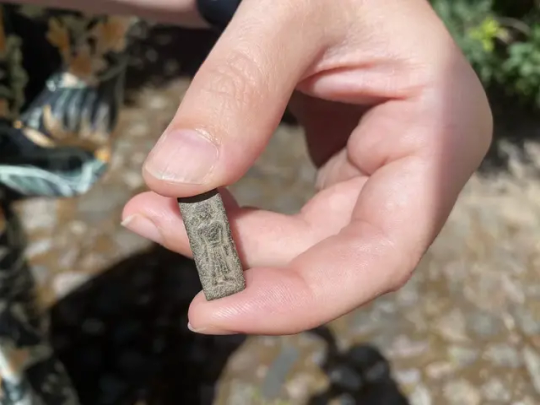
“It is actually difficult to see if it is a man or a woman who is depicted. You would see that by the fact that there is a tuft of hair on the back of the piston. But it may well appear that there is, she says, and emphasizes that it requires further investigations to determine whether this is the case.
As there may be more finds in the ground at the site, Museum Lolland-Falster does not yet want to publish where the find was made – but states that it was made in central Falster.
By Leman Altuntaş.
#Rare Ancient Stamps Found in Denmark#Falster Denmark#patrice stamp#ancient artifacts#archeology#archeolgst#history#history news#ancient history#ancient culture#ancient civilizations#Iron Age#viking age
54 notes
·
View notes
Text









Mernet Larsen (b. 1940, American) makes intriguing, humor- and tension-infused paintings featuring geometric figures that inhabit space in ways that defy gravity and conventional viewpoints.
The artist stages ordinary scenes—people playing cards or eating dinner, a faculty meeting, reading in bed—but constructs them with vertiginous, skewed spatial relationships that convey a sense of precariousness.
The disorienting treatment of perspective places the viewer inside and outside of the paintings at the same time, “as if they’re wearing the situation,” the artist describes. Along with the figures’ deadpan facial expressions and subtle body language, Larsen’s puzzling compositions reveal an essence of everyday human interaction. Wry, anxious and awkward, the paintings are frozen monuments that are simultaneously alien and familiar.
17 notes
·
View notes
Text

PORTRAIT OF JAMES STUART (1612 - 1655), FOURTH DUKE OF LENNOX AND FIRST DUKE OF RICHMOND, AS PARIS HOLDING AN APPLE
https://www.sothebys.com/en/buy/auction/2019/master-paintings-sculpture-day-sale/sir-anthony-van-dyck-and-studio-portrait-of-james
This portrait of James Stuart is one of two versions made by Van Dyck and his studio; the other is at the Musée du Louvre, Paris. While Larsen described our painting as a replica of the Louvre portrait, Barnes et al. accepted both as the work of Van Dyck and his studio under his direction (see Literature). Lennox appears here in the guise of Paris, the shepherd from Greek mythology tasked with awarding the golden apple to the fairest goddess.
Lennox attended Trinity College, Dublin and traveled the continent before being appointed Gentleman of the Bedchamber in 1625, knighted in 1630, and becoming a Privy Councillor in 1633. He was a close friend of King Charles I and supported the Royalist cause, lending the King large sums of money on two occasions. He was created Duke of Richmond in 1641 and was commissioner for the defense of Oxford 1644 - 46. He married Mary, daughter of George Villiers, 1st Duke of Buckingham; their only son Esme died at age eleven.
Lennox sat for Van Dyck three times: the first portrait of Lennox and his dog, dated to 1633, is full length and commemorates Lennox's new status as Knight of the Garter (Metropolitan Museum, New York).1 A second, horizontal portrait of circa 1636 depicts Lennox seated with his beloved greyhound again (Kenwood House).2 The head and the top of his blouse with jeweled clasp were taken from the Kenwood portrait and reused for the present image. From the third sitting, Van Dyck painted a full-length portrait of Lennox in black (Earl of Leicester).3 Lennox's family was among Van Dyck's most important patrons; his siblings are also the subjects of celebrated portraits from Van Dyck's English period.
22 notes
·
View notes
Text




Faaborg museum, Faaborg
This museum was gorgeous! It was opened in 1905 and you really notice the vision from back then. I love museums with colourful walls and the floor was amazing as well. This museum was made for the artist who lived on Funen. That pigeon painting was so cute.
0 notes
Text
THE EVENS ARTS PRIZE 2023

Exploring the critical imaginaries of AI The Evens Arts Prize 2023 is dedicated to artistic practices that challenge prevailing systems of knowledge and experiments new alliances between living beings and machines.
The Jury is composed of Daniel Blanga Gubbay, Artistic Co-Director, Kunstenfestivaldesarts; Nicolas Bourriaud, Artistic Director, 15th Gwangju Biennale; Elena Filipovic, Director and Curator, Kunsthalle Basel; Matteo Pasquinelli, Associate Professor in Philosophy of Science, Ca’ Foscari University; Gosia Plysa, Director, Unsound. The Jury Chair is André Wilkens, Director, European Cultural Foundation. Artistic Director: Anne Davidian, curator.
Focus of the Evens Arts Prize 2023 The widespread use of AI applications, particularly in the form of text-to-image generators and large language models, has sparked intense scrutiny and debate. These discussions, fueled by both excitement about their potential and concerns about their biases, bring to the forefront crucial questions about human subjectivity, autonomy, and agency.
Technical systems are deeply intertwined with social systems, shaping our lived experiences, aspirations, and politics. Together with artists, how can we better understand and address the impact of AI and the broader constellation of digital technologies and algorithmic politics? What new imaginaries and alliances can we cultivate between living beings and machines?
The new edition of the Evens Arts Prize seeks to highlight artistic projects that explore alternative cosmologies and epistemologies, question human exceptionalism, and shed light on issues such as surveillance, manipulation, extractivism, digital governance, justice, care, and responsibility in the age of machine intelligence. Of particular interest are practices that experiment with AI to challenge prevailing systems of knowledge and power asymmetries, mobilise technologies towards emancipatory community outcomes, and envision democratic futures.
The laureate is selected by an independent jury from a list of nominations put forward by representatives of major European cultural institutions.
The Nominators of the Evens Arts Prize 2023 Ramon Amaro, Senior Researcher in Digital Culture, Nieuwe Instituut, Rotterdam; Zdenka Badovinac, Director, Museum of Contemporary Art, Zagreb; Lars Bang Larsen, Head of Art & Research, Art Hub, Copenhagen; Leonardo Bigazzi, Curator, Foundation In Between Art Films, Rome; Mercedes Bunz, Professor Digital Culture & Humanities, King's College, London; Francesca Corona, Artistic Director, Festival d'Automne, Paris; Julia Eckhardt, Artistic Director, Q-02, Brussels; Silvia Fanti, Artistic Director, Live Arts Week /Xing, Bologna; iLiana Fokianaki, Founder, State of Concept, Athens; Cyrus Goberville, Head of Cultural Programming, Bourse de Commerce | Pinault Collection, Paris; Stefanie Hessler, Director, Swiss Institute, New York; Mathilde Henrot, Programmer, Locarno Film Festival; Nora N. Khan & Andrea Bellini, Artistic Directors, Biennale Image en Mouvement 2024, Geneva; Peter Kirn, Director, MusicMakers HackLab, CTM Festival, Berlin; Inga Lace, Curator, Latvian Centre for Contemporary Art, Riga; Andrea Lissoni, Director, Haus der Kunst, Munich; Frank Madlener, Director, IRCAM, Paris; Anna Manubens, Director, Hangar, Barcelona; Anne Hilde Neset, Director, Henie Onstad, Høvikodden; Nóra Ó Murchú, Artistic Director, transmediale, Berlin; Maria Ines Rodriguez, Director, Walter Leblanc Foundation, Brussels; Nadim Samman, Curator for the Digital Sphere, KW Institute for Contemporary Art, Berlin; Andras Siebold, Artistic Director, Kampnagel, Hamburg; Caspar Sonnen, Head of New Media, International Documentary Film Festival (IDFA), Amsterdam; Marlies Wirth, Curator for Digital Arts, MAK, Vienna; Ben Vickers, Curator, Publisher, CTO, Serpentine Galleries, London.
The Evens Arts Prize The Evens Arts Prize honours artists who engage with contemporary challenges in Europe and shape inspirational visions for our common world. Far from reducing artistic practice to a function – whether a social balm or a political catalyst – the Evens Arts Prize supports aesthetically and intellectually powerful work that pushes the understanding of alterity, difference, and plurality in new directions, questions values and narratives, creates space for silenced or dissonant voices, and reflects on diverse forms of togetherness and belonging.
The biennial Prize is awarded to a European artist working in the fields of visual or performing arts, including cinema, theater, dance, music; it carries a sum of €15,000. The laureates are selected by an independent jury, from a list of internationally acclaimed artists, nominated by representatives of major European cultural institutions.
The 2011, 2019 and 2021 editions were curated by Anne Davidian and celebrated Marlene Monteiro Freitas, Eszter Salamon, and Sven Augustijnen as laureates of the main prize, while Eliane Radigue and Andrea Büttner received the Special Mention of the Jury.
More about the Prize
📷 from Atlas of Anomalous AI, edited by Ben Vickers and K Allado-McDowell, Ignota Books, 2020
2 notes
·
View notes
Text








RCM Police St. Roch from Vancouver, Canada dated from 1928 on display at the Vancouver Maritime Museum, Canada
Royal Canadian Mounted Police, or RCMP, used ships like this schooner, to assert Canadian and British Imperial authority in couastal regions. RCMP were often the only official governemnt presence in the Arctic and so were the ones imposing the Canadian governments laws. This often included transporting Inuit children, against the families will, to resindential schools in or around the Arctic.
The St Roch is fampous for the RCMP's wartime duty of asserting sovreignty during wartime during the Second World War. From 1940 to 1942 the St Roch under captain Henry Larsen, a Norwegian immigrant to Canada, travelled the North West Passage. During this journey 8 members of crew died to heart attack.
Photographs taken by myself 2023
#naval history#royal canadian mounted police#canada#canadian#british empire#20th century#vancouver maritime museum#barbucomedie
2 notes
·
View notes
Text
Ace of Spades Fireteam
So, here is my pinned post, with a bit about my guardians! In my head, the three guardians you make in D2 is the young wolf’s 3-person fireteam. I play with my boyfriend, so essentially we have a 6-person fireteam, buuuuut, some of them aren’t fleshed out, so here is the basic info. Also, I should add that in my head, my bf’s titan and my warlock are the young wolves, and it is not just one person.
Bubo (she/her)--awoken warlock. Dawnblade. The YW. Ghost: Minerva.
She was rezzed in the Dreaming City at the time the young wolf was rezzed. She loves her dawnblade, but she uses all the light/darkness subclasses (except for stormcalling). She is the student of Ikora Rey and focuses on history, mainly of the awoken and lightbearers. She hopes to establish a museum in the city one day. She often gets in trouble, such as being the first Shadebinder, learning too much about her previous life, and wanting to keep an Ahamkara bone in her house in the city.
Tripore (he/him)--human titan. Sunbreaker. The YW. Ghost: Edgewise.
Tripore was rezzed in the Cosmodrome, a few years before Bubo. He loves the archives and has become a hidden who focuses on better data management. On the battlefield, he yeets as many nades as possible (and says "where's my hammer?" every five seconds). He loves doing photography and becoming a Dregen in his downtime. Bubo hates how much she is dragged into Gambit by Tripore.
Violet (she/her)--awoken hunter. Nightstalker. Ghost: Rose.
She was on the same fireteam as Cayde and Andal Brask and ended up being on this new light fireteam when she found Bubo in the Dreaming City. A hunter who is probably not the best influence on any new lights, but is quite effective at what she does. She mainly loves sniping, playing with knives, and drinking way too much alcohol.
Cynthia-28 (she/her)--exo titan. Sentinel/ Behemoth. Ghost: Lawrence
Cynthia was rezzed in the early city age. She has an old exo frame that constantly has issues, so she became an exo scientist to learn more about exos and to help others who don’t have the light/can heal themselves. She also tries to take apart our robot dog.
??? (she/her)--awoken warlock. Stormcaller. Ghost: ???
She still needs a name. She was rezzed in the late dark ages and has stayed away from a lot of the fighting, focusing on her studies instead. She ends up on Bubo’s fireteam just cause they needed a bit more firepower fighting Crota, and Bubo just happened to know her.
Shiro-4 (he/him)--exo hunter. Ghost: Suzume
Okay, we haven't had any lore on Shiro since D1, and I want to know what he is up to, so he is the final member of the Ace fireteam. I think he was on the same fireteam as Cayde, Andal, Violet, and Tevis Larsen years ago, but now Violet and Shiro are the last two from that fireteam. Like the unnamed warlock, Shiro is more so just there to help when Ace needs it and he is a reliable hunter.
#Ace of Spades Fireteam#Fireteam#Warlock#Hunter#Titan#Awoken#Exo#Bubo#Tripore#Violet#Cynthia#Shiro 4#Suzume#Lawrence#Rose#Edgewise#Minerva#Young Wolf#YW#oc stuff#Destiny#Destiny 2#D2#Destiny the game
2 notes
·
View notes
Text
LIVE SCHEDULE
共演する皆さんで、使うハーモニカや機材、音色が違います。それが僕のスタイルです。その時の自分に正直に。まっすぐ演奏しますので、どうぞ宜しくお願いします! 3/4 広沢タダシ / 滋賀 大津市伝統芸能会館 能楽堂 3/11 広沢タダシ / 下北沢 ニュー風知空知 3/16 とまべちなつき / 京都 Gorey Cafe 3/17 とまべちなつき / 大阪 猫のマダム 3/18 とまべちなつき / 岐阜 tamako 3/19 倉井智佳子 / 曙橋 Back In Town 3/20 木下弦二 & 倉井夏樹 / 辻堂 Bistro Zancn 3/21 with 伊倉まりえ & 矢後憲太 / 小田原MUSEUM CAFE and garden 3/22 即興の夜明け / 池袋 Absolute Blue 3/25 Regalos / 茅ヶ崎 Casa de Bamba 3/26 Stu Larsen & Natsuki Kurai / 藤沢本町 cafe&bar Calls 3/27 風響 / 四谷三丁目 homeri
4/2 矢井田瞳 / ビルボードライブ 東京 4/4 矢井田瞳 / ビルボードライブ 大阪 4/5 倉井夏樹 & 斎藤渉 / 辻堂 Bistro Zancn 4/7 倉井智佳子 / 茅ヶ崎 STAGECOACH 4/8 倉井夏樹 & 斎藤渉 / 前橋 中乃沢美術館 4/9 Regalos / 鎌倉 Tsuu 4/14 NONMALT / 元住吉 Powers 2 4/15 倉井夏樹 & 斎藤渉 / 瀬谷 ginkgo cafe 4/16 NONMALT / 新潟 GOLDENPIGS 4/18 NONMALT / 両国 SUNRIZE 4/21 NONMALT / 福岡 GRAF 4/22 Hitomi インスタレーション/ 代田橋 CHUBBY 4/23 Regalos / 横浜ホテルニューグランド 4/24 NONMALT / 青山 月見る君想う 4/28 とまべちなつき / 今池 バレンタインドライブ 4/29 とまべちなつき / 静岡 Living Room 4/30 とまべちなつき / 桜新町 NEIGHBOR
5/6 馬場俊英 / 大阪 なんば Hatch 5/7 馬場俊英 / 大阪 なんば Hatch 5/12 Regalos + Midori / 辻堂 Zancn 5/13 馬場俊英 / 愛知芸術劇場ホール 5/14 馬場俊英 / 愛知芸術劇場ホール 5/16 SUEMARR × カルメンマキ / 所沢 MOJO 5/18 倉井智佳子 / 横浜 Thumbs Up 5/20 倉井智佳子 / 北浦和 パラダイスロード 5/26 倉井夏樹 & 斎藤渉 / 中野坂上 LODI 5/27 馬場俊英 / 大手町三井ホール 5/28 馬場俊英 / 大手町三井ホール
and more… !!!
2 notes
·
View notes